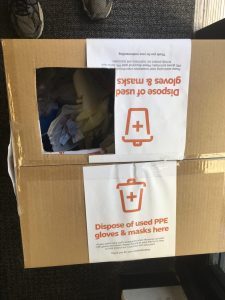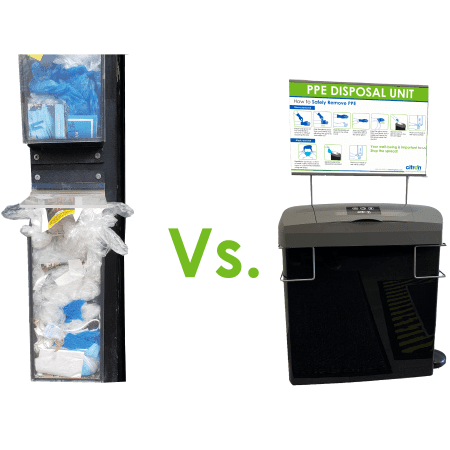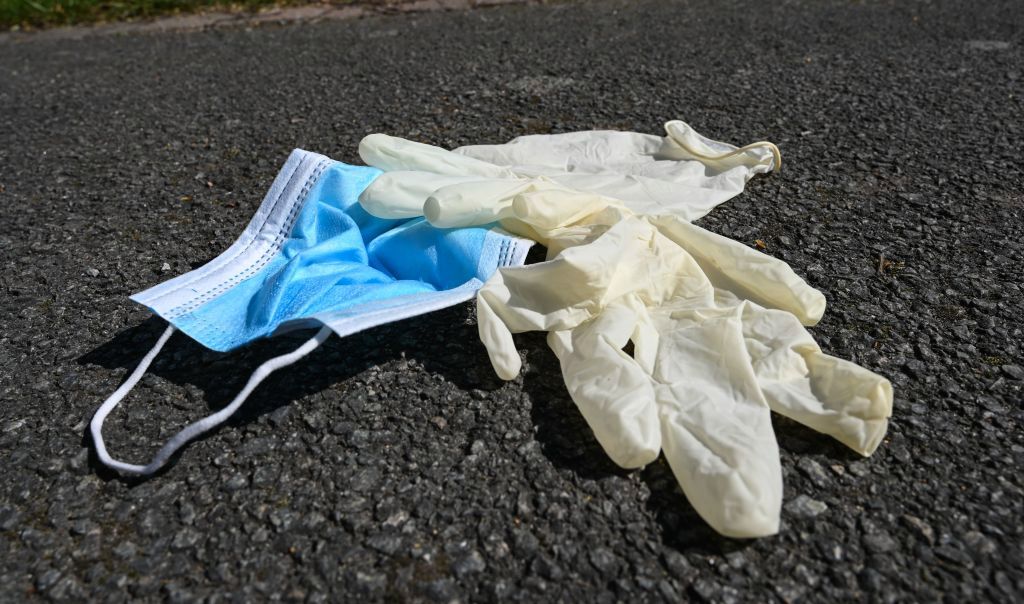Table of Contents
Updated on May 18, 2023


Now, restaurants, retailers, schools, and other service providers have re-opened their doors, and wearing PPE when entering indoor settings is now either mandatory or strongly recommended by many Provincial governments.
This has left many businesses scrambling to find an adequate solution for the disposal of PPE in their business. Some businesses are treating masks and gloves as regular waste and are not providing a separate disposal unit.
Others have opted to create their own make-shift PPE disposal bins but continue to treat it as regular non-infectious waste. Both solutions promote the spread of infectious bacteria, neither presenting a safe way to dispose of PPE.
In our blog post we will delve into the intricate world of PPE disposal, highlighting key considerations and offering practical guidance for effective waste management. As we navigate these unprecedented times, let’s explore together how we can contribute to a safer and cleaner environment by disposing of PPE in a manner that minimizes risk and ensures sustainability.
How is PPE kit supposed to be Disposed of?
The World Health Organization states that PPE should be disposed of in a closed-lid receptacle and not a regular garbage bin. This is because used PPE should be treated as infectious or offensive waste; ppe disposal should be handled in a way that prevents the transmission of infectious disease to the wider population. However, a closed-lid receptable that needs to be manually opened forces users to touch a potentially infected surface to remove their PPE. This process is the reason why a closed-lid, touch-free disposal unit is the best way to safely dispose of PPE.


Why is PPE Disposal on Service the Best Solution?
1. Overflow Promotes Littering
While having a safe disposal solution is a great first step, preventing overflow of disposal units is another problem businesses are facing. Masks and gloves are being littered on the street and are already making their way in our oceans and waterways. Having a dedicated technician visit your facility at a frequency that best suits you is the best way to ensure overflow is under control and prevent the littering of PPE.
2. Many People Don’t Know how to Safely Remove PPE
A 2015 study from the University of Wisconsin found that only 50% of health care workers know how to properly remove their PPE! Without a healthcare background, many people don’t know there even is a correct way to remove PPE. Luckily, Citron Hygiene’s PPE Disposal Units are always accompanied with educational signage clearly displaying how to safely remove PPE.
3. A Disinfected Disposal Unit for that Extra Layer of Protection
Every time your unit is serviced, the technician will disinfect the unit with our Health Canada-approved, hospital-grade disinfectant SolX-5. SOLX-5 kills 99.9% of germs and is likely to kill SARS-CoV-2.
Community-based Public Health and Waste Management initiative
The best way to prevent the spread of infectious disease are through community-based public health initiatives. Having proper PPE disposal available to all who enter your business helps prevent littering, gives your employees and visitors peace of mind, and prevents the spread of infectious diseases within your facility. Citron Hygiene has been partnering with businesses throughout the COVID-19 pandemic, helping them elevate their hygiene and keep their staff and customers safe. The use of PPE shows no signs of slowing, so it’s time for businesses to adapt to the new normal and make the switch to hands-free PPE Disposal Waste Bins.
Download our Free How to Remove PPE Properly Poster
Alongside your PPE disposal bins, why not educate the end-user on the proper removal of PPE to ensure it is done safely and hygienically. Download our free poster on how to dispose PPE that includes guidance on masks and gloves which can be displayed next to your bins in your facility.
Related posts:
- Infographic: Back to School Safely
- Infographic: Back to Work Safely
- How to Safely Open Schools During a Pandemic
- Dispose Of Tampons & Sanitary Pads – Outsourcing Needs
- Infographic: PPE Disposal
- Helping Businesses Open Safely with Our Range of Solutions
- Citron Hygiene: Helping you with all your Warewashing Questions
- Alcohol vs Alcohol Free Hand Sanitizer for Hand Hygiene – Guidelines
